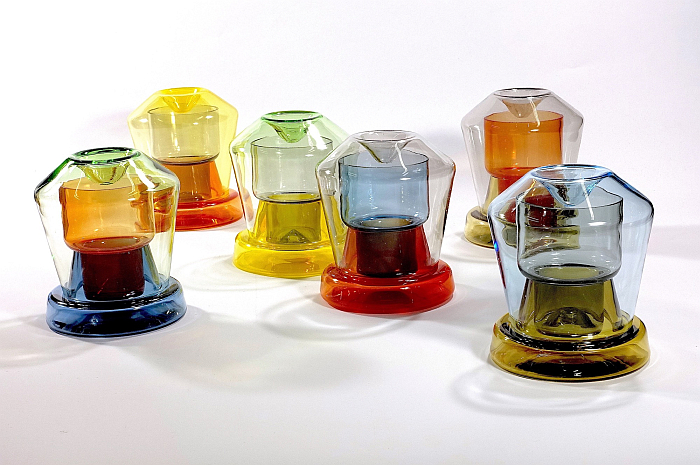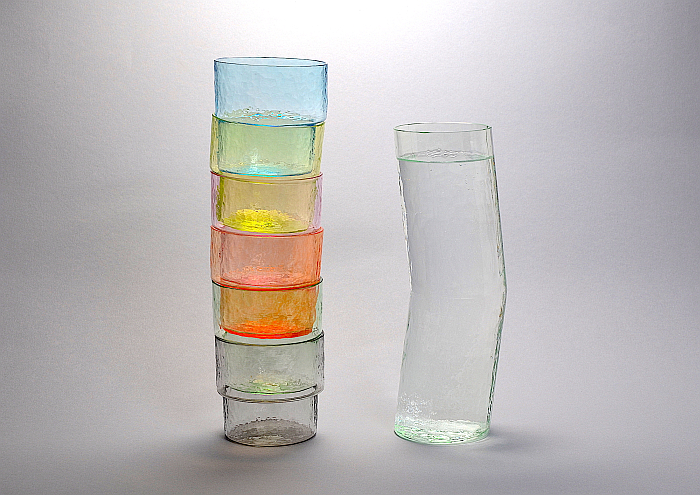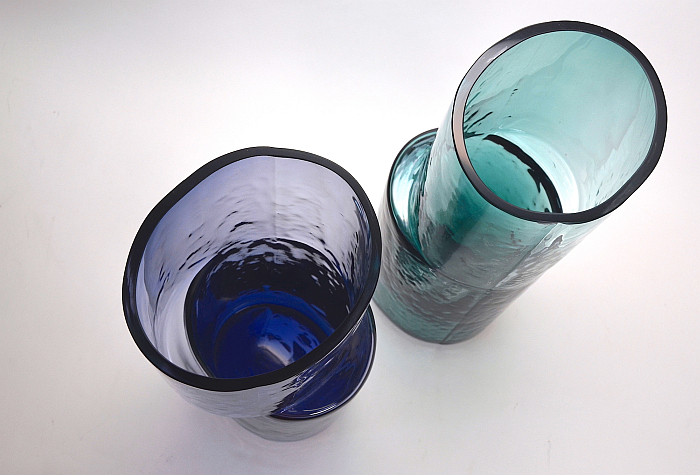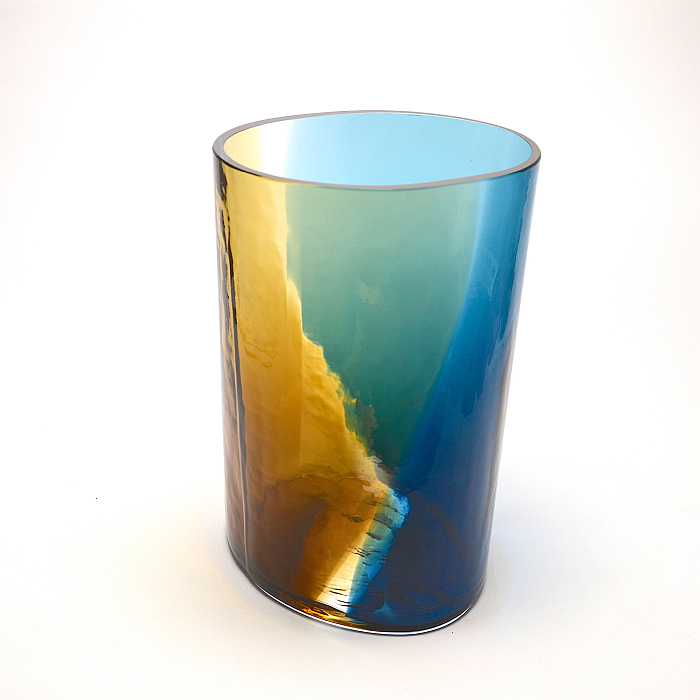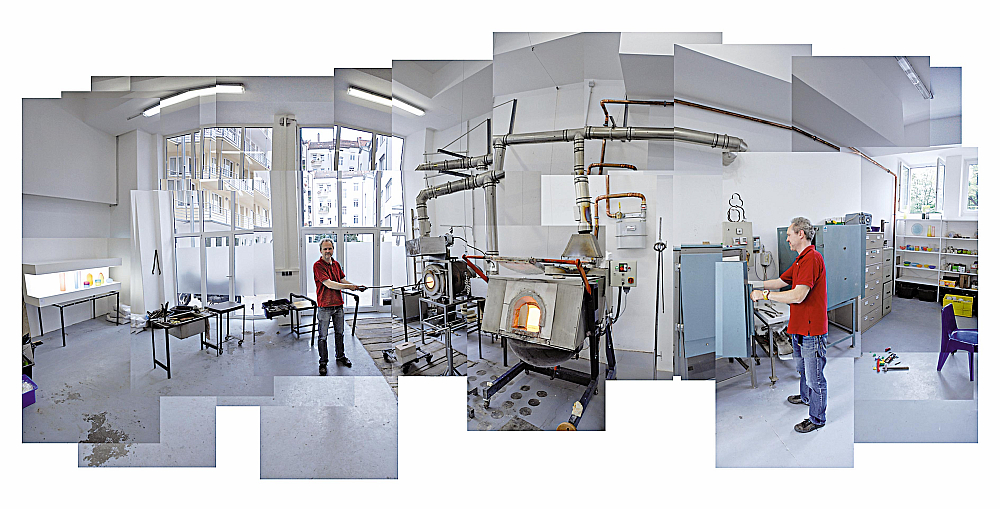Born in Coburg, Franken, in 1961 Cornelius Réer took his first steps in the world of glass via an apprenticeship at Glashütte Süßmuth, Immenhausen, near Kassel, followed by periods working in Austria and Sweden and a nine month course at Brierley Hill Glass Center in Dudley, England, before returning to Franken and establishing his own studio in Fürth in 1992. If a return to Franken punctuated by long absences: the next 11 years seeing Cornelius lead an, essentially, nomadic life, travelling Europe and realising his collections in numerous glass studios and presenting/selling them at trade fairs such as Ambiente Frankfurt. Collections whose focus is very much serial production, not the one-offs so often associated with glass; rather serially reproducible forms, albeit series which on account of their artisanal production, Cornelius creating each individual piece himself, means that every object is unique.
In 2003 Cornelius's nomadicity ended, at least professionally, with a return, full-time, to Fürth, before in 2008 moving his studio down the road Nürnberg, where today he creates series such as, and amongst many others, the Crunch glass collection, one of his longest running series, and, in many regards, his breakthrough series; the InsideOut range, a family of objects composed of a variety of forms that can exist individually or as collective; or the LUMEN2 lantern, Cornelius's re-imagining and re-working of a late 1950s lantern design by Egon Eiermann. Works defined, and at the risk of summarising more than is prudent, by their colour, by their interplay with light, by their material efficiency and by a functionality that is often simultaneously as playful as it is utilitarian, and as physical as it is immaterial.
And works which since 2023 have also been defined by rising gas prices: a glass studio is dependent on a lot of ovens, a lot of very hot ovens, ovens you can't turn off, and thus the gas price rises of 2023 saw Cornelius switch from wooden moulds to steel moulds, an alternative production process that not only reduces the energy demand of the production process, but very much defines the character of works such as, for example, the Pool beakers and carafes, or the O.V.A. and MODUL vases. Works that, on account of their genesis in Cornelius's response to the challenges of rising gas prices, are as much the result of design thinking as of craft thinking, and works which saw Cornelius Réer co-awarded the inaugural smow-Designpreis at Grassimesse 2023 alongside Budapest based design studio Line and Round, I O.
Alongside his own collections Cornelius is also co-author with Laura Jungmann of the project/brand SameSame, a project that began as a component of Laura's Diploma thesis at the Hochschule für Gestaltung, Karlsruhe, but which has since become autonomous; a project in which industrial glass objects, primarily, wine, beer and water bottles, are upcycled by Cornelius into craft objects that belie their industrial background, and which sees the intended re-use via recycling replaced with re-use via an infinite lifecycle. And just one of several cooperations undertaken over the years by Cornelius with students and professional product designers.
Following his success in Leipzig we met up with Cornelius in his studio in Nürnberg to discuss his work, his approaches, the realities of life as independent glassmaker and glass as a material, but we began asking why glass, why the decision for the glassmakers profession.......
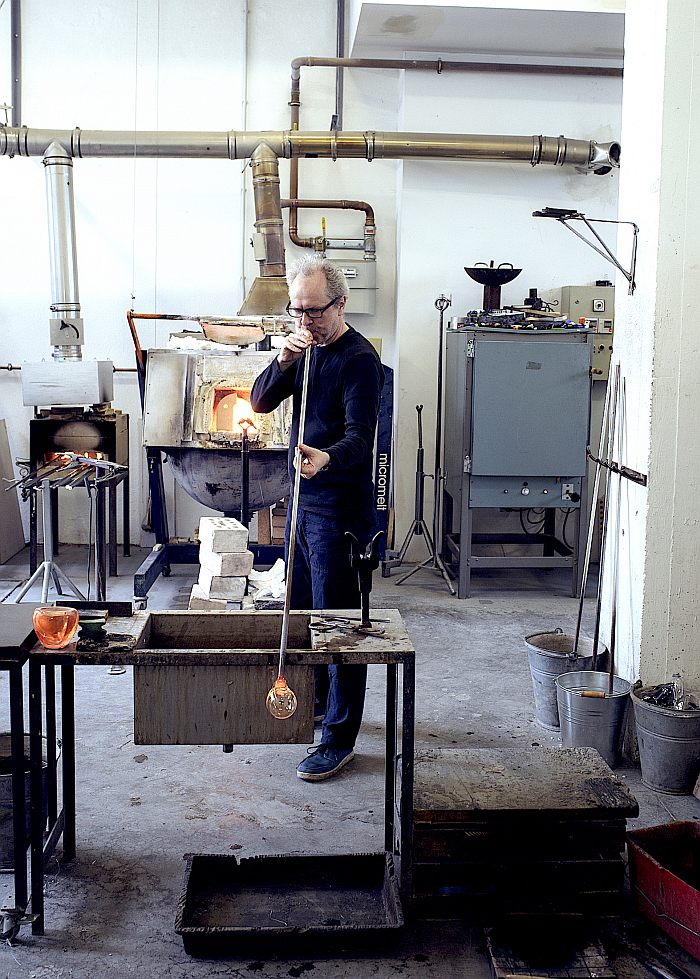
Cornelius Réer: I wanted to do something that no-one in my family had ever done before, that seemed very exotic to me. And also I was looking for a practical craft training, not an academic one. The apprenticeship was however more of a suffering than a training, it was truly miserable and exploitative. After completing the apprenticeship I then did my compulsory Zivildienst, and subsequently the question naturally arose, "What are you going to do with this project you've started?", and after much thought I decided to learn glass properly, to open up perspectives, because it is an incredible material.
smow Blog: The miserable, exploitative, apprenticeship was with Süßmuth in Immenhausen, wasn't that a kind of workers' collective at that time?
Cornelius: By the time I was there it wasn't any more, that was around 1972, I arrived in '81 and by then it had long since reverted to a privatized Hütte.
smow Blog: But presumably you thought that you would get a good education at Süßmuth. Why didn't that happen? What went wrong?
Cornelius: They had planned to establish a large, inter-company, training workshop and so took on a lot of apprentices; however, the planning was so chaotic that the hoped for funds were not approved by the state. As a result they had 15 apprentices too many, and who couldn't simply be laid off, instead 15 of the unskilled workers who normally put the finished glass into the tempering ovens were laid off. Many of them were the wives of the glassmakers which resulted in a lack of family income, which further worsened the mood. Overall the workforce shrank from around 160 to 90 during my three years at the company, they had major problems in all areas, and that was not a good basis for training.......
smow Blog: .......no, those are definitely not positive conditions, we can well understand that the atmosphere was less than constructive.......
Cornelius: .......whereby at the same time the company always had a good external image. They held international exhibitions, invited artists, organized summer workshops, and I had countless encounters there with individuals, some of whom are still friends today, who showed me that the glass world can be very different to that one I was experiencing. At that time the studio glass movement was very international and had a strong presence in Germany, and that gave me a good perspective.
smow Blog: And that's where the decision ultimately came from, as you say, to stick with glass?
Cornelius: Exactly, but get away from the Hütten. Although during that period most of the German Hütten went bust anyway.
smow Blog: You however not only left the Hütten, but also left Germany for England.......
Cornelius: First I wanted to learn by assisting in other studios, wanted to avoid going to school or college, so I worked in a studio in Sweden, but didn't really get anywhere due to my poor basic training, and which forced me to think again about schools, which took me to England. There was a great college there in Brierly Hill, where, if you look closely, about half of Europe learned the craft of studio glass. They offered in-depth training, and that not just at the oven, in the engraving workshop or cold processing, but also in areas such as business and oven construction. It was a nine-month course, the pragmatics of which I still benefit from today.
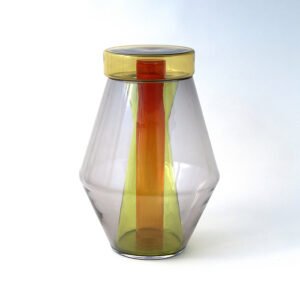
smow Blog: We'll skip over the nomadic years that followed England, although we do have a lot of questions about them, and focus on your work. When we look at your work we see four main features: the haptics, the colour, the function, something slightly playful - would you agree...
Cornelius: ...the form is also important, I'm a form person...
smow Blog: ...Okay, five key aspects. The next question is the same: there is obviously always an interplay between the different elements of a work, but does any one have a greater priority in your approach?
Cornelius: There is always an initial motivation for a piece, for example, you consider a certain surface and try find a suitable shape for it, or you think about a certain function, such as the whisky nosing glass that you lay on its side and roll across the table thereby allowing the aromas to be released. Ultimately, everything happens simultaneously in the design process, just with different focuses from project to project.
smow Blog: In that context, how do you understand what you do? Is it glass craft, glass design, glass art?
Cornelius: I do it all, each aspect in its time. I know that with what I do I am helping maintain a craft, as it has become a rare craft, but that alone is not my motivation. The motivation is always to develop projects, that's the best thing. Producing objects is the second best. When I started out I saw myself in this environment of glass artists, this whole studio glass movement, now however, I appreciate that many creatives from other areas, such as silversmithing or ceramics, are much closer to me than many glass colleagues in terms of thinking. Ultimately, I work in the field of Angewandten Kunst, Applied Arts, I don't like the term 'Kunsthandwerk' Handicraft even though it's exactly right, but as a term it has something of a antiquated overtone, which is something I try to avoid.
smow Blog: Whereby we would say that you are doing very well. When we look at your work, a few projects stand out for us in particular, one of which is the SameSame project with Laura Jungmann. How did that arise?
Cornelius: In addition to my own collection I also often work for product designers and assist students with projects of various kinds. Laura asked me if I could do the glass part for her Diploma thesis, whose focus was upcycling in various materials. It was a wonderful collaboration, although pressed glass is intrinsically immune to any kind of manual processing. However, after a year of work I managed to develop it to a stage of product maturity, and we both agreed that the idea was so strong that we should establish it as a company.
smow Blog: Given that you probably knew how difficult it would be, why did you still agree?
Cornelius: The request came at the beginning of the year, there wasn't much going on [laughs]. No, I did a quick test, it worked wonderfully, I agreed and told Laura, 'don't worry, I'll realise it for you'. And subsequently produced a huge mountain of broken glass, by the time a part of her thesis was finished I had created a vast trail of devastation, but that was also necessary to overcome the technical difficulties of pressed glass versus studio glass. However now I know how to do it.
smow Blog: And aside from overcoming pressed glass, was it a project you learned from?
Cornelius: I learned a lot, and it strengthened my way of thinking about functionality, and also thinking about how I can design a mass-produced product with individual nuances without actively altering it. Serial production gives me the security that I can repeat objects without having to rely on luck, and so the development of SameSame has impacted what I do today.
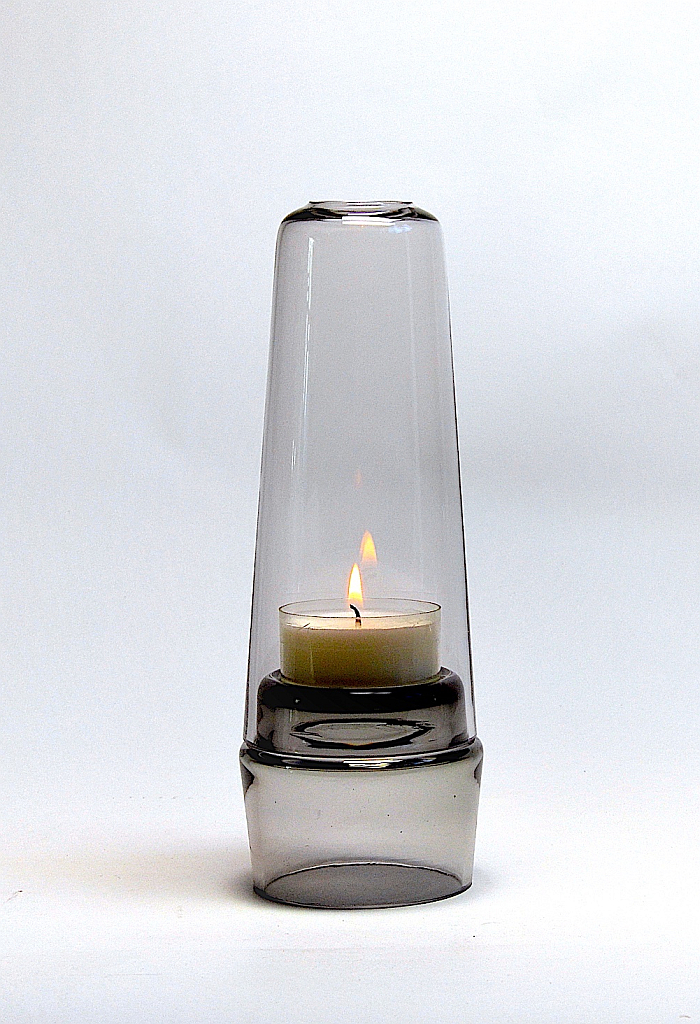
smow Blog: The other product that caught our attention is the LUMEN2 lantern, an object based on a 1950s lantern by Egon Eiermann, and during our research we learned that Eiermann designed his lantern for Süßmuth...
Cornelius: ...exactly, Eiermann developed it for the 1958 World's Fair for Richard Süßmuth, whom he knew. However, it was only produced for about two years, and today it is a sought-after collector's item...
smow Blog: ... and how did your new interpretation come about...
Cornelius: ...the Eiermann Gesellschaft, who own the design rights, wont release them or allow a re-edition. Thus over the years I've had several requests to recreate it and I've always said no, there are rights to it, I'm not allowed to produce it. But I really liked it myself, it's a really nice product. So after some thought I came to the conclusion that this basic idea, this two-part structure, this raised position of the light so that it doesn't sit completely on the ground, is something I could reinterpret, also with the colour scheme that I have. It is one of my favourite products.
smow Blog: Did you know about it during your time at Süßmuth?
Cornelius: Yes, yes, it was greatly disliked the glassblowers because the lower part was so complicated to produce, which also means that I would be very reluctant to recreate it today because it really is unnecessarily complicated, certainly the lower part, the upper part not so much. I simplified it all a little in my object.
smow Blog: It's interesting that you say that you were drawn to the Eiermann version because we see some of the basic ideas of Eiermann's lantern, for example this two-part design or a form that is functional and decorative at the same time, in a lot of your work. Could one say that your understanding of design is influenced by Post-war Modernism.......?
Cornelius: I think about that question a lot because people often say that what I do is reminiscent of the 60s. I don't see it that at all. I don't base myself on the '60s, but at the same time I know that what's around me, the mid-century '60s that I grew up with, is there, that I see it. But I also grew up with the promise of Modernism that it is worthwhile developing something new, developing something that doesn't yet exist. Which is a wonderful path, a Modernist way. That's why I don't see myself in context of the 1960s because I'm working for today. But maybe other people need to judge what I actually do.
smow Blog: It's also interesting that you effectively started your career at the end of Postmodernism, when criticism of Modernism was waning and many creatives found a way back to Modernist positions...
Cornelius: At the beginning, what I knew from Sweden was absolutely crucial for me. This clarity and at the same time playfulness, Kosta Boda, for example, had series that were incredibly playful while maintaining a strict clarity, they pulled of a wonderful balancing act. Kosta Boda had a design department that was far too big; the Hütte couldn't produce that much, later many designers were laid off and for a decade production was based on the drawers full of designs. It was really exciting to see what possibilities I have in terms of playfulness and what options I have in terms of reduction. My line crystallized somewhere in between.
smow Blog: A line that is also heavily based on series. Why series? Why the focus on series?
Cornelius: I like this serial work because through the process of making a deepening occurs on account of the amount of time you spend with it. The path to a piece is crucial for the subsequent pieces that develop from it; if I make a really good design today, one I like, it will eventually become a follow-up product. In every good project is the seed for the next. I think that's really typical of this type of craft that I do, execution and the development of new thoughts are inextricably linked.
smow Blog: Your most recent work, or perhaps your most recent process of using steel moulds instead of wooden moulds, came about less as an evolution of an existing project than as a response to rising gas prices…
Cornelius: Energy costs have always been a big factor for the studio, and gas costs increased fivefold in 2023. Which is worrying development, a threat to the entire European glass industry, from the large factory to individual makers like me, for example, there were hardly any Czech Hütten at the last Frankfurt fair. That also made me want to find an answer. Hopefully, it remains to be seen, but hopefully I have found a way to produce pieces cost-efficiently and quickly, so that I use as little energy as possible for a large output of pieces. It is a design idea and at the same time an artistic idea because with the steel form I am breaking the established rule of axial symmetry, which I do with great joy, and the pieces have their individual look, their individual feel, something very artistic has emerged from a series product and I'm happy with it.
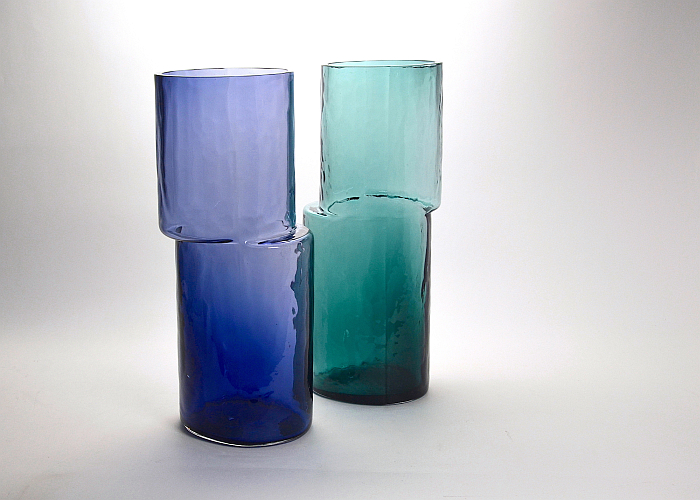
smow Blog: And this process with the steel moulds, is that something you knew about, discovered or developed in response to rising gas prices?
Cornelius: During my apprenticeship I saw flawless objects crafted with steel moulds, what I'm showing today are actually mistakes, for example these cold wrinkles, the visibility of the mould seams, also the asymmetry, all of this should be avoided. I also have pieces that are a little older that also work with this technology, that show these flaws, but I have now brought it the fore with the new works. It's always development work, I have never invented anything in my life, I have always developed ideas that were already there into a new form or a new product.
smow Blog: And how are the energy savings achieved?
Cornelius: The pieces are created in two stages, first, blowing the glass into the steel mould, and then cutting and cold processing. It means a lot of grinding work with only a little refining. For example, for the Pool beakers, I spend one day at the oven and two days in the grinding workshop, the workshop stage once the furnace has been tempered, which means that while the overall production time is a little longer, the time at the oven itself is quick.
smow Blog: In an interview we read you described the process as "quick and dirty", we liked that....?
Cornelius: [laughs] It's not really "quick and dirty," but it is quick, at least relatively speaking. And it is also a technique that absorbs material difficulties and irregularities well. I don't let everything through, but a lot is nodded through, these pieces are error tolerant.
smow Blog: You developed the process in response to rising gas prices. Given the very, very high energy consumption in glass production, wasn't it necessary or even mandatory for the glass industry to reduce its energy consumption under the current realities?
Cornelius: Of course we have to do that. This means thinking about, for example whether to collectivize studios, share them, to look for forms that are not so energy intensive, or work with materials that don't require high temperatures. However, there is no silver bullet. There will be many small steps. Electric ovens are an interesting solution, but naturally the manufacturers have doubled the prices of these ovens, delivery times are long, and the question of how the piece is heated during the moulding process has still not been resolved. We still have a long way to go, with very little time.
smow Blog: Returning to your comment that the new process is "error tolerant", is glass an easy material to work with, we suspect not, but have never tried?
Cornelius: There are two difficulties with glass. Firstly, getting started with hot glass, learning the technique can be incredibly frustrating and it takes quite a long time to complete your first satisfactory piece, it takes longer than in other disciplines, with ceramic, metal or wood, the first satisfactory products are easier to achieve. The other difficulty is that not many people know much about glass, especially in artistic terms. Glass is a material that is full of vain seductions because it is so shiny, because it invites kitsch and every possible exaggeration, and such pieces exist and are vociferous, Blown Away, the Netflix series, has given an indication in which direction this can all go. But for me limitations in simple design, simple colours and simple lighting effects always mean that less often leads to more beautiful results.
smow Blog: Which could also be viewed as a Modernist way. You've been in the glass business for about three decades now. How has the market developed over the years? Has it become more difficult to be an independent glassmaker?
Cornelius: It's always been difficult to find a market, especially because your own perspective as a creator is not the buyer's perspective. That is the real difficulty of the whole thing, you have to succeed in getting people to follow your perspective. From the beginning, I didn't sell directly to end customers, but rather to shops; however retail has also changed over the years, there used to be specialist glass shops that had everything from jam jars to traditional art glass, a huge world of glass in one shop, which is completely unthinkable today. In addition, the scene that produces such works has become smaller, I rarely see people today producing work comparable to mine. On the one hand, this is due to the design of what I do and, on the other hand, as I saw at the last Grassimesse, due to general developments; many colleagues have moved away from serial objects towards individual pieces, the development towards unique pieces is very strong. But my roots in the Hütte are always present, I'm very stuck in a serial mindset, honing the good ideas so that they result in fantastic products, that's the task. It's wonderful to start a series product and develop it further, but it doesn't necessarily correspond to the current trend. I happily admit to having a nerdy way of working.
smow Blog: In a positive sense, obviously, and maybe others will move to more serial work. But by then you will probably have evolved, which brings us to the question of the future, of the next steps.......
Cornelius: A long-term plan is to delegate a few products to companies, that is to bring some products to the point that someone else can manufacture them. That appeals to me as a next step. The other thing is to consider light in more detail. I have series such as, for example, TRIII or InsideOut that are screaming out to be pendant lamps, so that the light plays a larger role in the colour. It would be fantastic to be able to realise that development, but those would then remain under my production here in the workshop.
smow Blog: And as a last question, at the beginning you said that despite the initial setbacks, you decided on a career in glass, not least because it is a "incredible material". Why are you still working with glass after 30 years?
Cornelius: Because I can do it [laughs loudly]. It was difficult for me to find this career path, the way I do it today. In the first few years I was given little and I had to fight for a lot, self-empowerment played a major role in the first ten years and I've learned a lot during this whole process and I don't want to lose this language because it doesn't bore me in any way. It could go on like this for another thirty years!
More information on Cornelius Réer and his work can be found at https://cornelius-reer.de
And in late 2023 Bayerische Rundfunk also visited Cornelius in Nürnberg, the Capriccio feature can be found, German only, in the BR Mediathek
